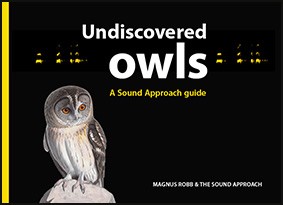Undiscovered Owls
The discovery of an apparent new species of Strix owl in Arabia last year, subsequently named Omani Owl, has created even more anticipation for this volume. Taxonomists have been aware that our zoogeographical region is likely to contain several cryptic and potentially splittable forms of owl, and The Sound Approach's 'hands-on' ability to independently research these possibilities has meant that knowledge has increased at a faster rate than it could on ever-tightening academic budgets.
Each volume revolves around original field recordings and the differences which can be heard between different bird populations, subspecies and species, encapsulated in The Sound Approach's slogan 'Understanding bird sound'. The high quality and atmospheric recordings are made in the field by lead author Magnus Robb and others mainly on expeditions set up specifically to collect these sound samples in carefully selected geographical locations.
The interlinking text and recordings mean that Undiscovered Owls is a personally engaging and interactive experience. Consecutively numbered recordings on the four CDs are continually referred to and meant to be listened to as you read. Adjacent to these are annotated sonograms of each recording, too, enabling details of the sound to be 'read' and become more apparent. This now-familiar method was a pioneering innovation in the very first Sound Approach book and has been a defining feature since, but it really does work with practice — you hear the nuances and fluctuations of each hoot and shriek more clearly under visual instruction, and appreciate the authors' subtle evaluations.
But the headline purpose of the book for most will be the "undiscovered" forms they didn't know about before, or further confirmation of those they may have suspected. So, let's do the splits.
Immediately, the first chapter on the barn owl genus Tyto declares three new island endemics "for the sake of argument": Slender-billed Barn Owl on the eastern Canary Islands, plus the eponymous Madeira and Cape Verde Barn Owls. Straight away, we can see some of the fascinations and difficulties behind The Sound Approach's methods.Without a confirmatory molecular study, the differences in physical proportions and minor plumage and call divergences could perhaps be the result of a 'founder effect' — features derived from a skewed gene sample provided by a small number of original colonists — or Foster's rule, where island species change in size and proportions. While the authors briefly discuss the lack of genetic studies, some might argue it would be more taxonomically valid to keep these forms as subspecies pending further research. Turkish Fish Owl is split from Brown on the basis of its calls and a 2 per cent DNA disparity, but based on limited samples (though this is hardly surprising given its near-mythical status until recently).
That's not to say that the authors aren't correct on all these points, of course, and it is riveting seeing the discovery of the different forms unfolding through a mix of travel book, expedition log and detective story.
Further splits suggested are a strongly presented one between Little Owl (western Europe and Iberia) and 'Cucumiau' (North Africa, eastern Mediterranean and across the rest of Eurasia), which many birders won't have suspected before (see Birdwatch 275: 62-67), as well as the split of Cyprus Scops Owl from Eurasian, while because of the book's coverage of the entire Arabian Peninsula, Arabian Scops Owl (split from African Scops Owl) also gets a chapter. Arabian Eagle Owl (split from Spotted Eagle Owl) gets its own account, too, while Pharaoh Eagle Owl remains separate from Eurasian, and 'Lapland Owl' is split from the North American Great Grey Owl. The recent conflation of the two Ural Owl subspecies in Europe seems further confirmed by the recordings in the book.


Sonograms comparing the songs of Little Owl (top) and 'Cucumiau'.
The fragmentation of Tawny Owl continues apace with a chapter on Maghreb Wood Owl, which has a deeper call and darker plumage than Tawny, and was in fact viewed as a good species a century ago. The recent controversy over Hume's and Omani Owls is addressed in the book as an addendum, and the team stick to their guns in retaining Omani as a new species, but reserve judgement on the published revelation that the type specimen of Hume's was also a different species that may correspond to Omani, and which was also given a new scientific name by other authors (see Birdwatch 272: 82). Pragmatically, they leave a full conclusion open to further research.
This is a sumptuous and eye-opening read, as well as an authoritative reference for years to come. The joy of discovery and the pains of detailed hard work are profuse throughout, and the book remains an engrossing read due to Robb's pleasingly conversational style. It will also give adventurous birders plenty of scope to plan trips to see — and hear — these mysterious and hard-won species for themselves.
Special offer
Undiscovered Owls by Magnus Robb and The Sound Approach is available for a limited period with an exclusive discount of up to £5 — click here for more details.




